Leeds United are back in the Premier League after 16 long years. The Championship winners under Marcelo Bielsa have been a rejuvenated side playing extraordinary football. They scored 77 goals in the campaign and conceded the least goals, 35 in 46 games last year.
This year they have started the campaign well considering they have faced two of the Premier League top guns already. They have scored nine goals and conceded eight in the first four matches.
In this tactical analysis, we will assess Marcelo Bielsa’s defensive tactics and how they have fared so far in the Premier League. The following analysis is based on the games played against Liverpool, Fulham, Sheffield United, and Manchester City.
Leeds’ defensive organisation and tactics
-
Principle system
Leeds United operates in a collective man-to-man marking system. Each player is responsible for their respective man defensively. The standard rule is to have numerically plus one in the last line of defence and minus one in the first line of defence. That means one centre-back is free from marking responsibility, acting as a cover defender/ stepping out to close the dribbler and the forward deals with more than one player when Leeds are out of possession.
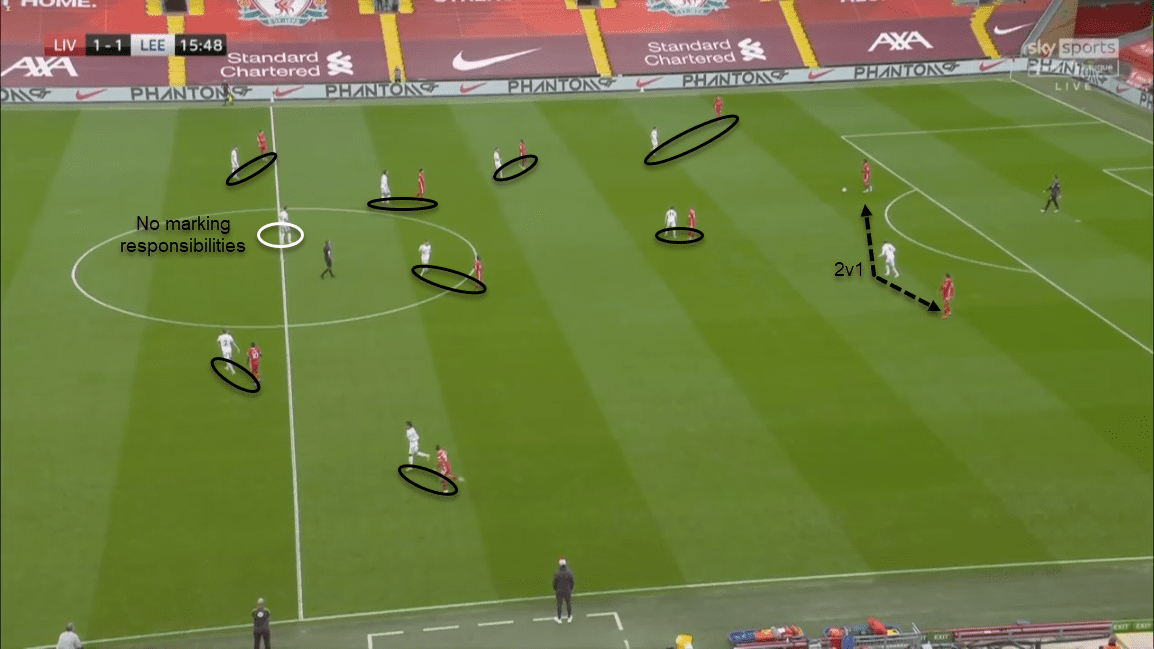
This is a part of the team’s philosophy irrespective of the opponent they face. This is why they are adaptable to different formations with the same group of players. Against Sheffield United, which is a side that plays in 3-5-2, Leeds too changed their formation to adjust their man-to-man marking. Dallas moved to midfield from the left-back position for the game to balance the marking. Leeds still had ‘plus one’ superiority with 3v2 in defence. Tyler Roberts supported Bamford ahead to combat the three centre-backs, having a ‘minus one’ in the first line of defence. Therefore, without making any substantial changes, Leeds is capable of adapting against any system by maintaining its core principles.
The Whites change their defensive shape based on the opposition’s build-up strategy. Leeds will appear in a 4-2-3-1 if the opposition is playing with lone pivot or they will shape in a 4-1-4-1 against double-pivot due to their strict marking.
-
In opponent half
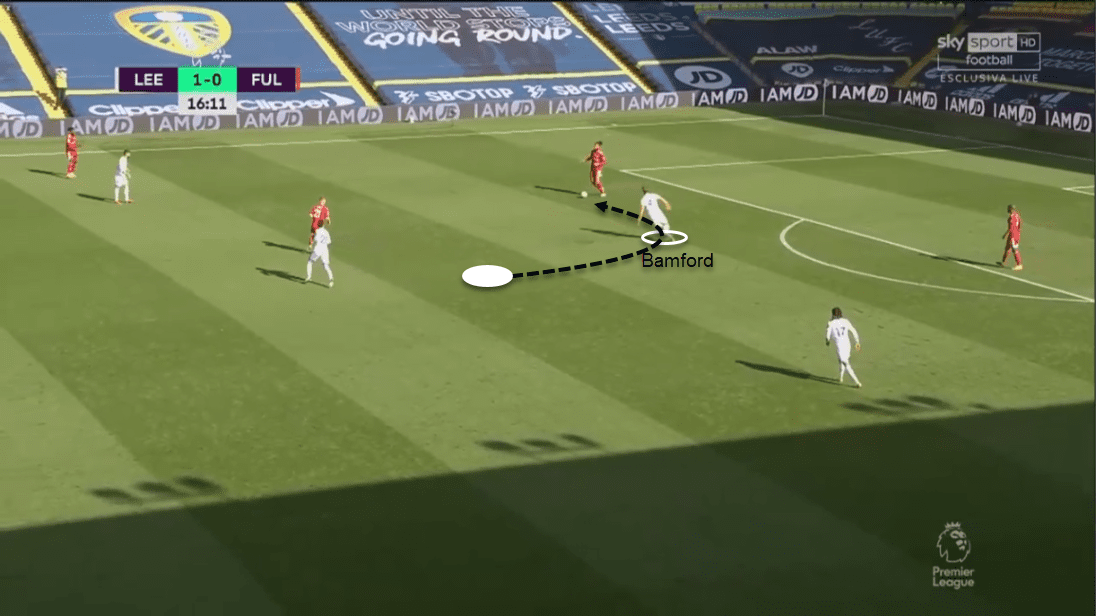
Bamford’s role is crucial in dictating the direction of play from opposition’s build-up. Since he is up against two centre-backs, he deals with this numerical disadvantage with his smart pressing angles. His movement to press is outward to inward, this helps in eliminating the lateral option (other centre-back) and the goalkeeper. This encourages the centre-back on the ball to play wide and forward where all the players are marked tightly. Bamford’s movement is key in making the play predictable and nullifying the numerical advantage.
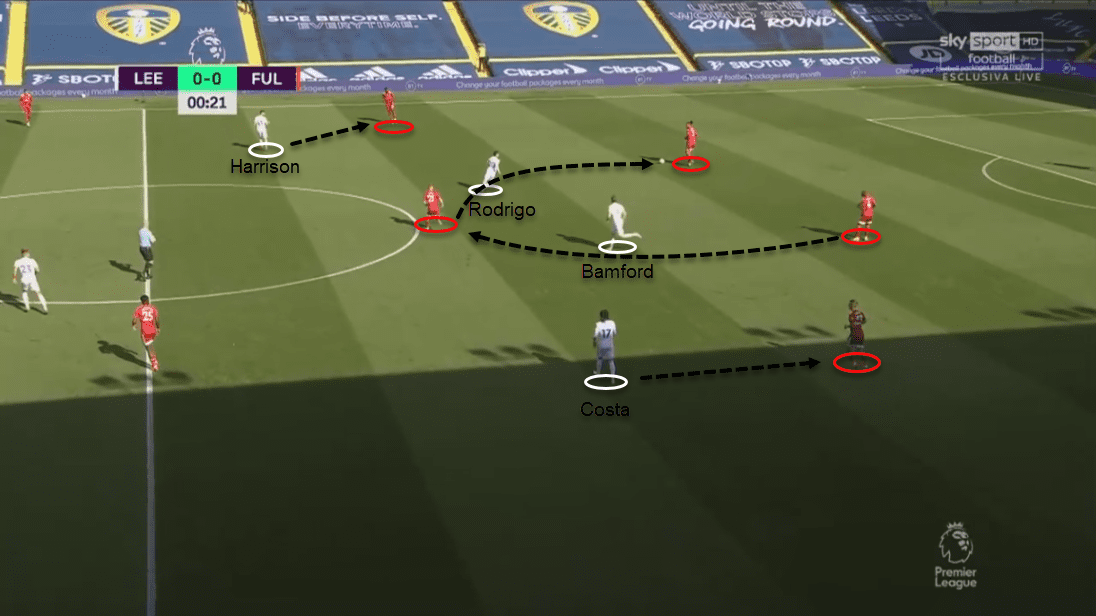
He also combines with the pseudo no.10 (CM marking opposition pivot) to execute the upper pendulum pressing. That is, Bamford and Roberts/Rodrigo shift duties to mark the opposition pivot tightly when the centre-backs pass to each other and press them accordingly. The wingers mark the full-backs and only join the press when the opposition goalkeeper is involved. In such case, Costa/Harrison stations themselves between the opposition centre-back and full-back to support the forward in press. This system in the offensive half makes it very difficult for the opposition to progress the ball. It forces them to go long as there is a lack of free options.
-
Defending in own half
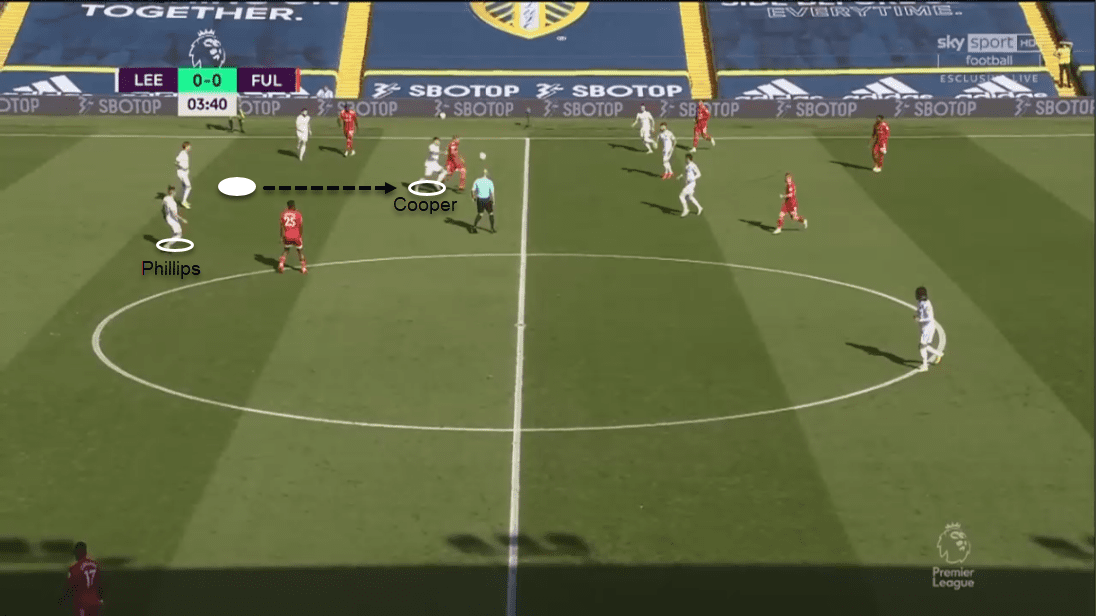
In the defensive half, the functionalities remain the same for Leeds. Bielsa demands great effort from his side to ensure the system works efficiently. Any movement from the opposition is supposed to be tracked by their respective marker. The wingers are expected to track the opposition full-backs when they join the attack. The backline sustains with enough security from a free defender. When the opposition forward drops to support his team, Leeds’ centre-back tracks him all the way to put pressure from the back and force a mistake. In such events, Phillips drops into the backline and covers for the pressing centre-back.
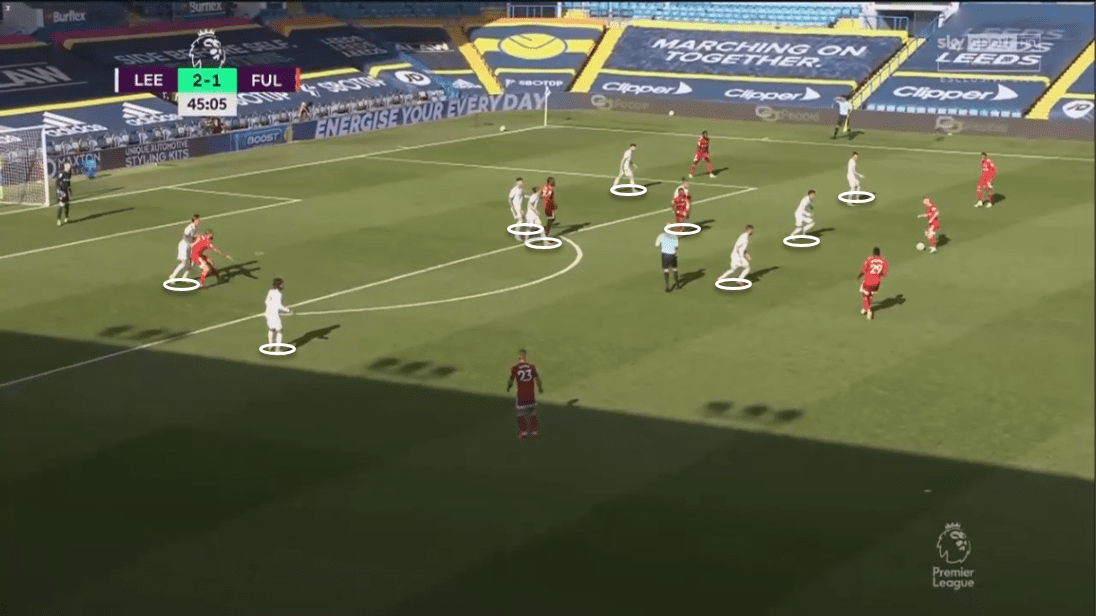
Due to the strict man-marking tactic, the shape of the team often appears to be compromised. Because the team is responsible to retain the possession individually. Bielsa’s emphasis on 1v1s has drilled his players to effectively contest for duels. The Whites track the players like their shadows applying constant pressure on them. Hence reasonably, they have put 773 pressures (highest in the league) in just four games of Premier League. They have tackled players 105 times in four games and won possession on 71 occasions (highest in the league).
However, they have made 19 interceptions so far which is relatively average when compared with the other clubs. This further advocates their defensive style and tactics of collective man-marking. The players are in a constant endeavour to get behind the ball and mark their players at the same time. The strategic marking makes it difficult for the opposition to find easy passes and at times leaves dribbling as the only option.
-
Dealing with players beating their markers
Realistically it is not possible to win every duel and tackle every dribble. So what happens if a player gets past his marker against Leeds? Since it’s important for other players to stick to their men, till what point and until what distance are they committed to it? Bielsa uses the ball as a line of reference to resolve the issue.
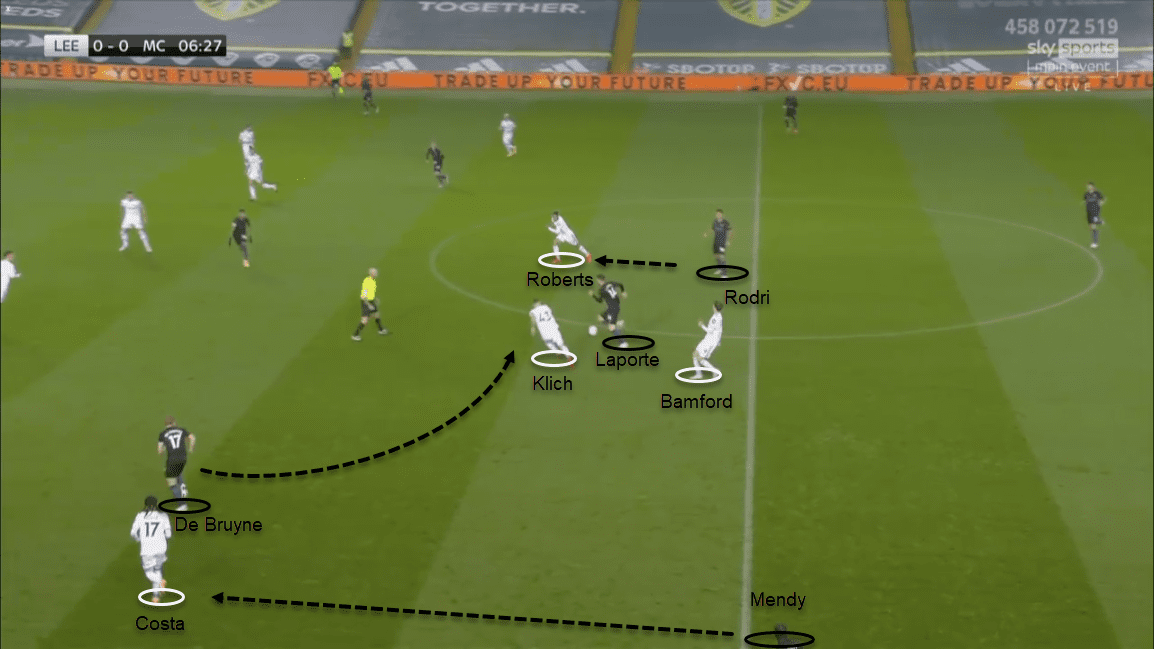
To explain it with an example, look at the scenario against Manchester City. Laporte got ahead of Bamford who couldn’t stop his run. Roberts left his man Rodri to close down Laporte from his right. Costa’s support in the right time enabled Klich to peel off De Bruyne and press Laporte. Both Klich and Roberts closed the channel and forced a back pass.
The most important point here is to understand the timing of players’ movements to press. If we realise both Rodri and Mendy are out of play (behind the ball carrier- no active threat) in this situation. This is an indication for Roberts and Costa to peel off their men in order to support behind. Costa’s timely switch from Mendy fosters Klich’s press away from De Bruyne.
Phillips plays a huge role in dealing with such free runners. He splits the direction of the run from the player he is marking and forces the run wide. This tactic of using the ball carrier as the reference line serves as a great solution to protect the team when a player loses their marker. However, the peeling off has to be well-timed and must be executed at an appropriate angle. Besides it also requires good communication and understanding of the team. Otherwise, it can lead to a 2v1 situation or a free man darting into the penalty area with the ball.
Issues pertaining to this style
-
Runners from the back
The opposition centre-backs get a maximum license to get forward against Leeds. In the game against Liverpool, Joe Gomez carried the ball and covered 192 yards (second-highest in his team) in progression. Denis Odoi and Michael Hector of Fulham covered 397 yards and 248 yards respectively. On occasions, teams also find their pivot in free space to receive the ball and run ahead when they have used their goalkeeper to attract press from Leeds. Peeling off their target players to stop the runner works well for Leeds when the runner is close to the player they are marking.
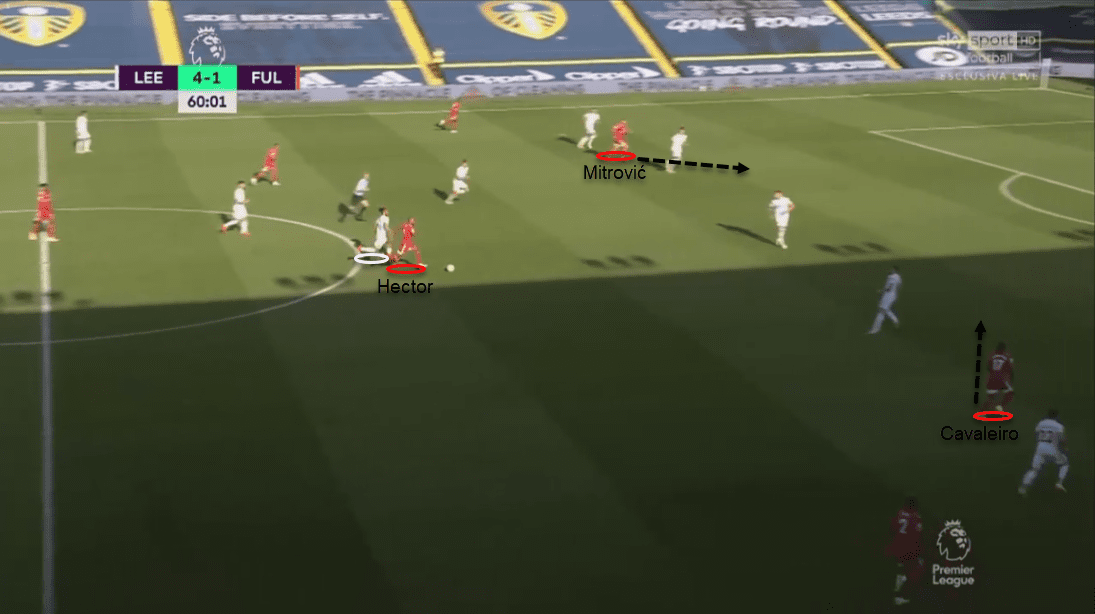
Opposition teams have also shown intelligent moves where the players pin the Leeds’ marker and drag them wide to pave way for pivots and centre-backs. It is especially effective when Phillips’ target player drags him wide. His positional sense is brilliant otherwise and is very capable of stopping such runs. The freedom offered to these pivots or centre-backs can hence be punishing if they find the final pass. They have been fortunate to not suffer from it. Therefore it is a risk Leeds are ready to take as not many teams are brave to commit their centre-backs all the way up the field.
It would be interesting to see if teams like Manchester United, Brighton or Arsenal could take advantage of this as their centre-backs Maguire (8411 yards), Webster (5950 yards) and Luiz (5689 yards) had the highest ball progression through carries amongst centre-backs last season. They will need to do more than just carrying the ball at the right time as they must add some creative edge to their game.
-
The backline organisation
Leeds United’s defensive style gives them a good control on the number of players but not space. Their defensive shape is dependent on the opposition and therefore results in being unorganised. The markers have their priorities in sticking to their players rather than establishing the defensive line, compact shape, and defending space around them. This has led to severe repercussions for them.
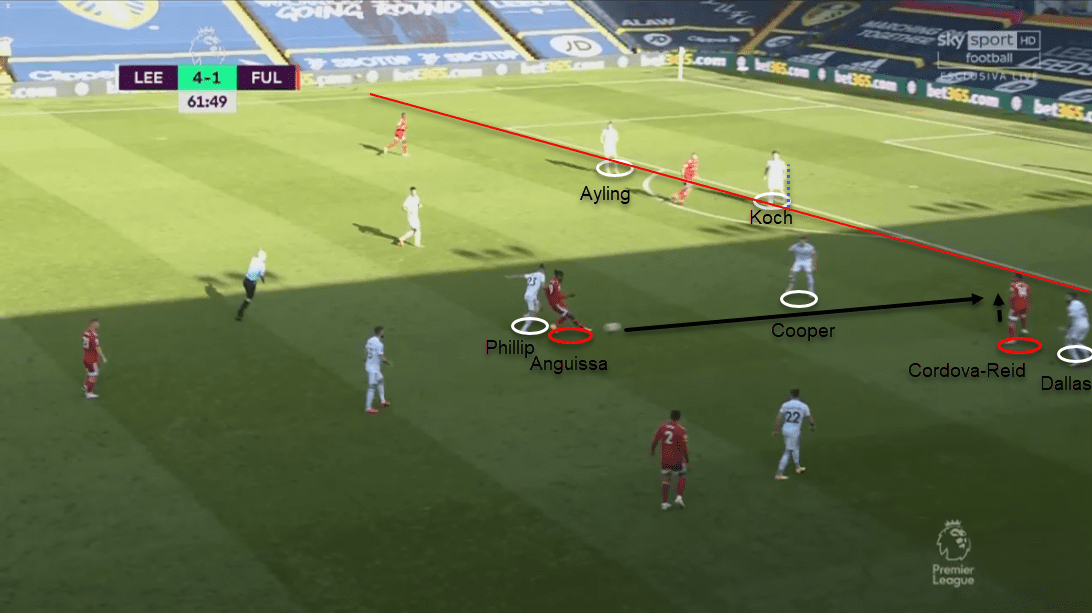
When Leeds played Fulham, Zambo-Anguissa managed to skip past Phillips after they won the ball from Leeds’ build-up. Despite the Leeds’ defenders getting back close to their marking players, their shape was unorganised and there was a lot of distance between them. Cooper who was relieved from marking on that occasion was too distant to close Zambo-Anguissa. Koch and Ayling held the line back as they were marking their respective players. Therefore, Decordova-Reid had enough space to run in behind without worrying about being offside. He scored the second goal for Fulham and brought them back in the game.
Leeds United was easily exposed with just one player getting away from his marker. The shape of the backline is worrying as they can’t afford to give time to the players on the ball in the defensive third. Leeds has been prone to runs behind their defenders from the opposition in all their four matches without catching them frequently offside.
-
Lack of cover
While the defenders have done a good job in dealing with their men and in winning duels, the Whites have to still be very careful with their tackles. This is because each player has his own marking responsibility; as a result, they don’t have adequate cover to support them. This leads to them defending deep as they can’t risk committing early on.
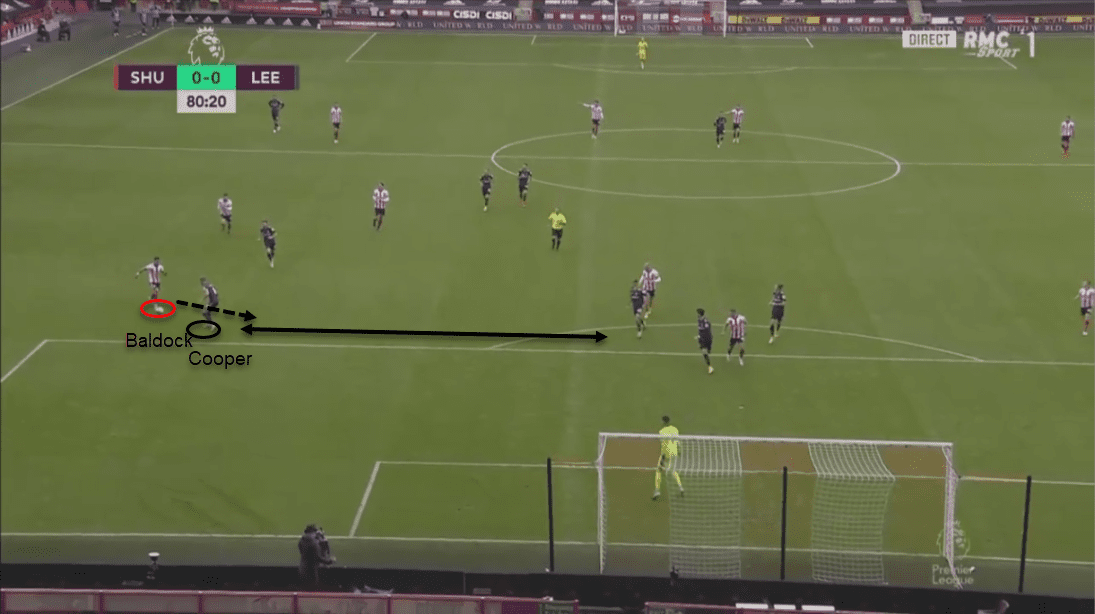
The wingers take this opportunity and try to cut inside. The full-backs are caught flatfooted like against Manchester City. Sterling dribbled across the defence line horizontally from the left and curled one past Meslier. Otherwise, if they track the run, they leave space for full-backs to overlap. Against Fulham, Costa had committed himself ahead to help Bamford press the goalkeeper. On receiving the ball, Cavaleiro cut inside and pulled Ayling with him. This left Bryan completely unmarked when he made an overlapping run on the left-wing. Cavaleiro passed to him and then Koch brought him down in the box to give away a silly penalty.
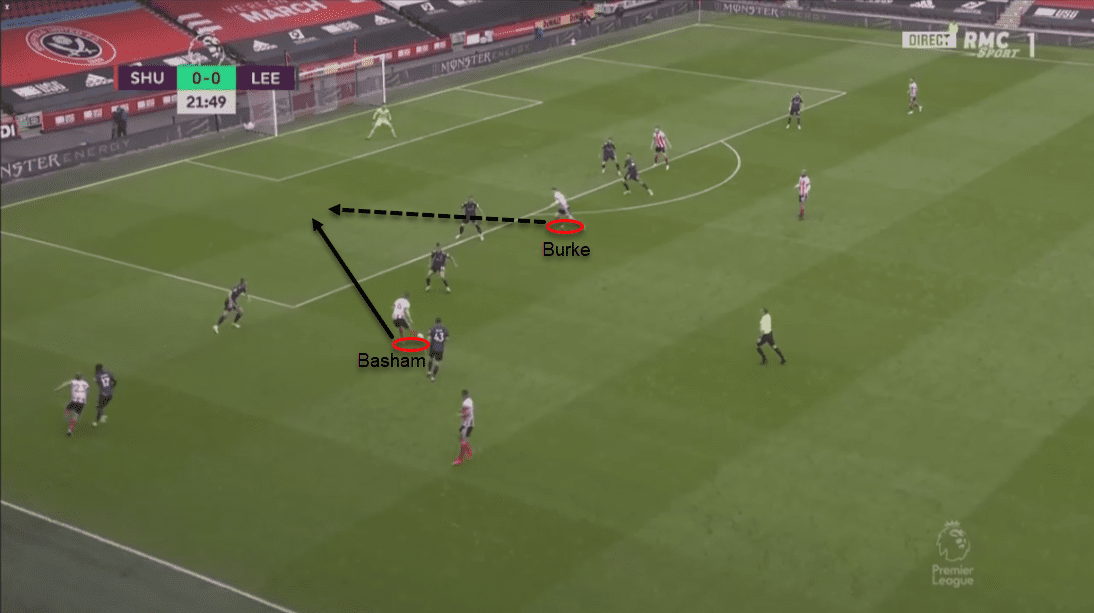
Sheffield United too exploited this space in their own way by playing consecutive reverse balls.
Transitions
A team’s behaviour in defensive transition majorly depends on their attacking formation. Leeds United tends to push five to six players (sometimes even seven) into the opposition’s 18-yard box while attacking. This makes them very susceptible to turnovers.
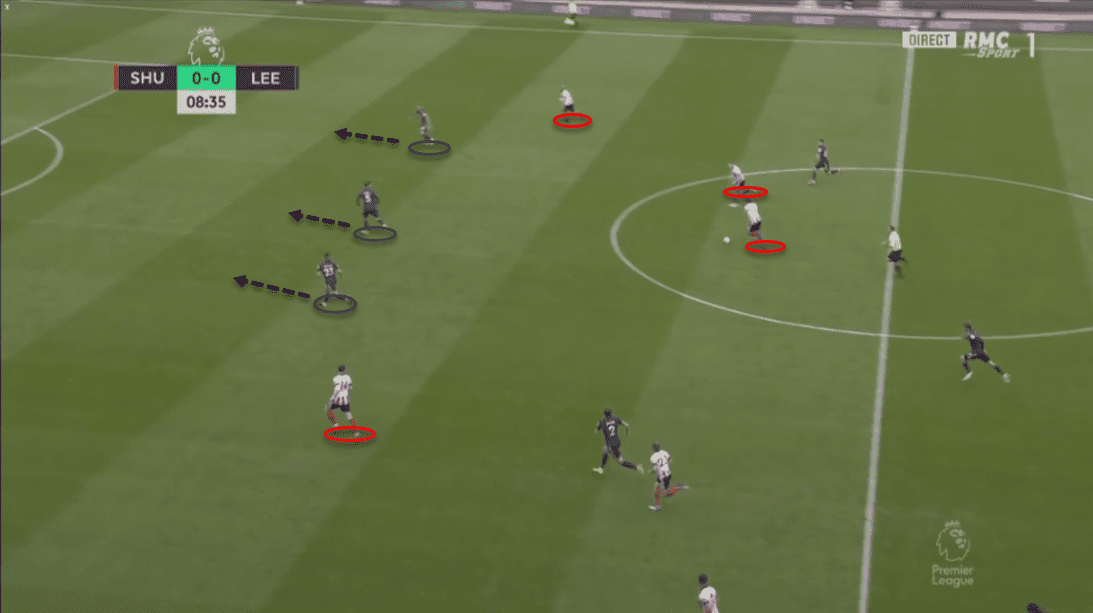
They face these defensive transitions with either an equal number of players or even less number of players. However, they have managed to be very impressive in defending these counter-attacks. The backline doesn’t charge forward to retrieve the possession. The Whites have phenomenal work-rate to recover and therefore the defenders track back deep into their penalty area in order to buy time. Phillips is generally the first line of confrontation who tries to diverge the play wide.
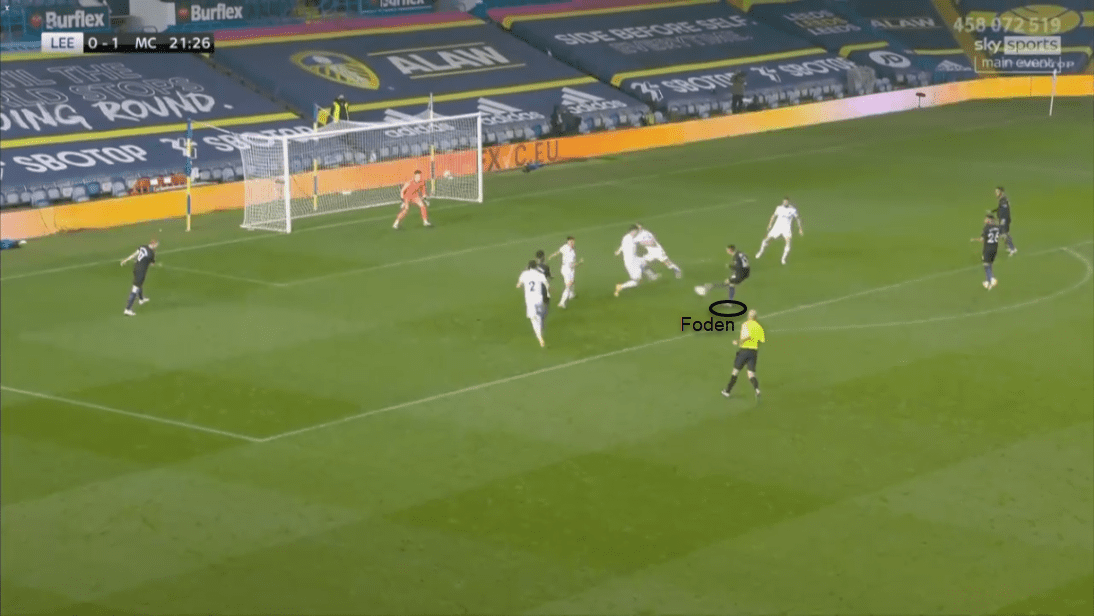
Otherwise, the team gets compact and waits for the opponent to make their move. They are comfortable in defending in their penalty area and are prepared to lunge in to block the shots. They top the charts with 29 shots blocked already this season. The sheer commitment to defend in the box with such confidence is commendable.
Set-pieces
Nothing much changes about the defensive ideas when it comes to set-pieces. Leeds followed the same man-to-man marking strategy in this phase of the game. It works wonders in throw-ins for them as they don’t shift responsibilities but just track their players. The third equaliser against Liverpool was from winning the possession from Liverpool’s throw-in. Now that’s quite impressive against a team that has hired a specialised throw-in coach.
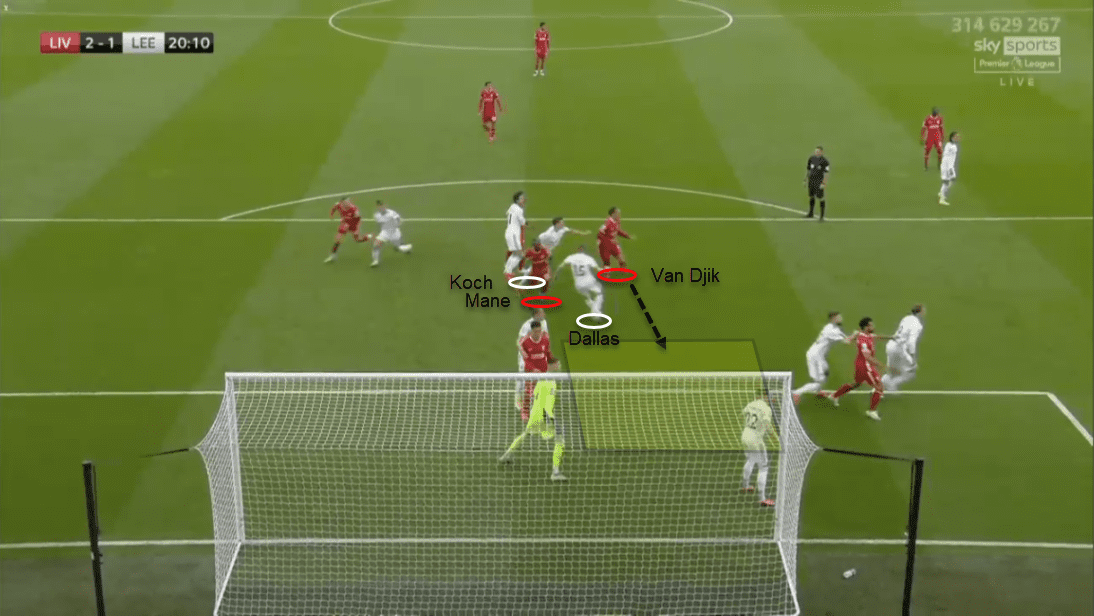
However, the same strategy has opposite effects in corners. In the same match against Liverpool, Leeds United adopted a complete man-marking system in corners. Liverpool players used the ‘Train’ tactic to the line-up, due to which Koch couldn’t mark van Dijk from the start. As the corner was taken, Salah moved ahead of front post vacating that area for van Dijk to arrive. Mane moved backward to impede Koch’s movement to get to van Dijk. van Dijk won a free header and he thumped it in at home for taking the lead. Leeds had no zonal players to guard the six-yard box. Given their 45.4 win % in aerial duels, is complete man-marking the best option for set-pieces?
Summary
The newly-promoted side has had a bright start in the Premier League. Leeds United have shown their attacking calibre against the top sides like Manchester City and Liverpool already. As we saw in this scout report, there is still room for improvement defensively. They have conceded three penalties and five out of the eight goals from set-pieces. This clearly makes it the prime concern and should be dealt with immediate effect. The defenders have been fantastic individually but the backline needs more structure for the upcoming games.





Comments